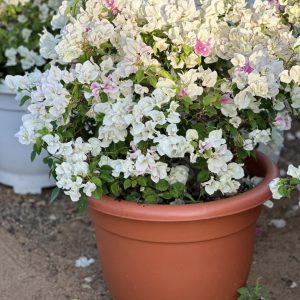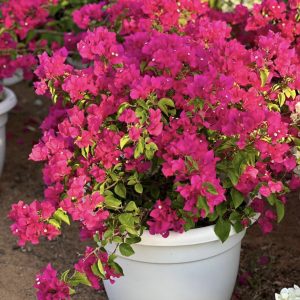Size : 1.4M-1.5M
Dracaena draco, commonly known as the dragon tree or dragon’s blood tree, is a fascinating and distinctive species that captivates with its unique appearance and cultural significance. Here is a more detailed description of Dracaena draco:
Trunk:
The dragon tree has a stout and massive trunk that can grow to impressive sizes. The trunk is usually thick and robust, covered in grayish-brown, rough bark. Over time, the bark develops deep fissures, adding to the tree’s character.
Canopy:
The branches of the dragon tree radiate from the trunk in a parasol-like fashion. They spread horizontally and curve gently upward, creating a rounded and symmetrical crown. The branches tend to be thick and sturdy, able to support the weight of the long, arching leaves.
Leaves:
The leaves of Dracaena draco are one of its most striking features. They grow in dense rosettes at the ends of the branches. The leaves are long and sword-shaped, measuring around 60 centimeters (24 inches) in length. They are leathery, rigid, and often have a bluish-green or grayish-green hue. The leaves have distinct parallel veins that run their length.
Resin:
When someone cuts or injures the bark of the dragon tree, it exudes a thick, dark red resin known as “dragon’s blood.” This resin is sticky and viscous, and people have historically used it for various purposes. They have used it as a dye, varnish, incense, and in traditional medicine.. The resin hardens upon exposure to air.
Flowers:
The dragon tree produces small, creamy-white flowers that are arranged in clusters called panicles. These flowers have a pleasant fragrance and are pollinated by insects. However, the dragon tree is a slow-growing species, and it may take several years for it to reach maturity and start flowering.
Fruits:
After successful pollination, the dragon tree develops small, spherical fruits that are about 1 cm in diameter. These fruits are usually orange or yellow when ripe and contain one or two seeds. The fruits are not commonly seen on cultivated specimens but are more common in mature trees in their natural habitat.
Habitat:
Dracaena draco is native to the Canary Islands, Madeira, and Cape Verde, where it thrives in arid and subtropical climates. The dragon tree is well-adapted to rocky and volcanic terrains and can tolerate periods of drought. It often grows on slopes, cliffs, and hillsides, utilizing its extensive root system to anchor itself.
Cultivation:
Due to its distinctive appearance, gardeners popularly cultivate the dragon tree as an ornamental plant in various regions around the world. It can grow in well-drained soil and can adapt to both full sun and partial shade conditions. However, gardeners should note that it requires a frost-free environment and is best suited for climates similar to its native habitats.
Dracaena draco is a remarkable tree with a striking silhouette and a rich cultural history. Its ability to withstand harsh conditions and its association with myths and legends make it a captivating species that continues to inspire awe and admiration.
Gardeners commonly know Dracaena draco as the dragon tree or dragon’s blood tree, which is a captivating species that they can cultivate as an indoor or outdoor plant.
Dracaena draco care tips:
Lighting:
Dragon trees thrive in bright, indirect light. When grown indoors, place them near a window where they can receive plenty of filtered sunlight. Avoid exposing them to direct sunlight, as it can scorch their leaves. In outdoor settings, they can tolerate full sun but also appreciate some shade during the hottest part of the day.
Temperature:
Dragon trees prefer moderate to warm temperatures. They can tolerate temperatures down to 50°F (10°C) but thrive between 65-80°F (18-27°C). Protect them from cold drafts and ensure they are not exposed to freezing temperatures.
Watering:
It is important to allow the soil to dry out partially between waterings. Overwatering can lead to root rot, while underwatering can cause the leaves to droop or curl. Aim to water your dragon tree thoroughly, allowing excess water to drain away. Always check the moisture level of the soil before watering again.
Humidity:
Dragon trees can tolerate average humidity levels, but they appreciate slightly higher humidity. To increase humidity, you can mist the leaves with water or place the plant on a pebble tray filled with water. Grouping plants together can also create a microclimate with increased humidity.
Soil:
Use well-draining soil for your dragon tree. A mixture of peat moss, perlite, and sand works well. Good drainage is crucial to prevent waterlogged roots. Ensure the pot or container has drainage holes to allow excess water to escape.
Fertilization:
Feed your dragon tree with a balanced, water-soluble fertilizer during the growing season (spring and summer). Follow the instructions on the fertilizer packaging for the correct dilution and frequency. Avoid over-fertilization, as it can cause salt build-up in the soil.
Pruning:
Prune your dragon tree to remove dead or yellowing leaves, encourage bushier growth, and maintain its desired shape. Use clean, sharp pruning shears and make clean cuts just above a leaf node. You can also trim off any leggy or excessively long branches to promote a more compact form.
Pests and Diseases:
Dragon trees are generally resilient to pests, but they can occasionally suffer from infestations of spider mites, mealybugs, or scale insects. Regularly inspect your plant for any signs of pests and treat them with appropriate organic or chemical insecticides if necessary. Overwatering or high humidity can make the plant susceptible to fungal diseases, so ensure good air circulation around the plant.
Propagation:
Gardeners can propagate dragon trees through stem cuttings or by air layering. To propagate through stem cuttings, take them from healthy, mature plants and allow them to callus before planting them in a well-draining potting mix.. Air layering involves making a small incision on a lower branch and covering it with moist sphagnum moss until roots develop.
By following these care tips, you can enjoy the beauty of Dracaena draco and help it thrive in your indoor or outdoor space. Remember to monitor your plant’s specific needs and make adjustments accordingly to ensure its health and vitality.






Reviews
There are no reviews yet.